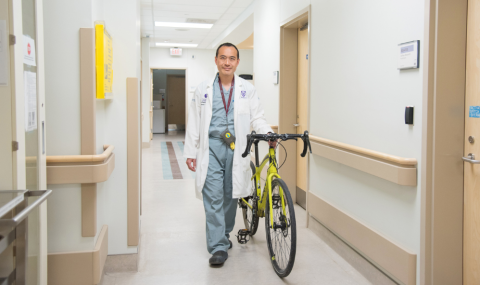What is an EMG Test?
An EMG test is a detailed investigation of the health of your peripheral nervous system (basically, this means all of the nerves outside your brain and spinal cord). There are two parts to the test: a nerve conduction testing and an optional needle exam (see below). In the nerve conduction studies (NCS), various nerves, usually in the arm or leg, will be stimulated with a small, harmless electrical pulse. The response from your nerve is recorded by an EMG machine. By testing a number of nerves, a generalized assessment of your peripheral nerves and muscles can be made. A number of specific localized problems such as Carpal Tunnel Syndrome, Bell's Palsy, Myasthenia Gravis, and many others can also be tested using NCS techniques.
For further general information, see our EMG informational pamphlet (PDF).
Will there be needles?
Some of our tests do involve using a very small needle. This needle is placed gently into specific muscle groups, depending on the problem we are investigating. It is important to note that not all of our studies require needle EMG. Whether or not you will need needle EMG depends on what your doctor has asked us to investigate. The needle used in our test is probably the smallest needle you will ever get.
The needle acts like a microphone and picks up the electrical activity in your muscle, which can then be evaluated to see if there are any abnormalities. Our needles, in addition to being very small, do not inject anything, nor do they take any samples from your muscles, they just 'listen' to your muscle.
Does it hurt?
For some people, there may be a small amount of discomfort associated with the nerve conduction studies. Most patients describe it as being similar to receiving a small 'static shock' from a doorknob or carpet in the winter. The majority of our patients tolerate this part of the test very well. In addition, all of our staff have had these tests many times, so they are able to understand your concerns.
There can be some minor discomfort during the needle examination but many of our patients report surprisingly little discomfort from this part of the test. If a patient finds this too unpleasant (which happens only rarely) the test can be stopped at any time.
Do I have to fast?
No, fasting is not necessary for these tests. You may follow your regular meal schedule. You should probably refrain from drinking several cups of coffee within an hour before the test to minimize the need for bathroom breaks.
How do I prepare for the test?
See our complete list of instructions (website).
Do I need to stop taking my medication?
In most cases, there should be no need to stop your medication for this test. However, you should check with your referring physician prior to your test date.
What should I wear?
It is best to wear loose clothing that is easy to remove. Do not wear long underwear, pantyhose, etc. You may bring a pair of loose-fitting shorts and t-shirt if you wish.
How long will it take?
Your test may take from 45 minutes to two hours (rarely) to complete, depending on the question asked by your referring doctor.
How long will I have to wait?
We do our best to see all our patients on time. Occasionally there are delays, but usually you will not wait any longer than about 15 minutes from your scheduled time.
What are they testing for?
EMG testing is done to investigate the health of your nerves and muscles. There are a large number of different nerve problems which can be tested for, so we cannot be more specific here. Your referring physician (the one who is sending you to us) is best qualified to answer any specific questions you have regarding the reason for your referral.
When will I find out about the test results?
Once your testing has been completed, the physician supervising the lab will discuss the results with you before you leave. The EMG physician will then dictate a report which will be sent to your referring physician.
It is important to remember that the EMG test may not provide a diagnosis of your problem. The EMG test is like one piece of a jigsaw puzzle; your referring physician will evaluate the results of your EMG test along with the results of any other investigations which may be necessary to arrive at a diagnosis.
Is it an ultrasound?
No, an EMG is an entirely different test. Ultrasound is a form of imaging, using sound waves and is performed by the Radiology department.
Can I drive afterwards?
You will be able to drive after your test or do anything else that you would normally do.
Can my spouse/child/relative come into the exam room with me?
If you are accompanied by a family member, the family member can usually be in the room with you during testing, providing that you approve of this. For reasons of patient privacy and confidentiality, relatives and friends may not accompany you during the test if you do not wish them to. Your privacy is our priority.
How do I get to University Hospital?
We have driving directions and detailed site maps for University Hospital on the London Health Sciences Centre (LHSC) website. Since LHSC has multiple campuses in London, make sure you look only at the Maps & Directions for University Hospital.
Where is the EMG Lab in the hospital?
The EMG Lab is on the 7th floor of University Hospital. When you arrive for your appointment, after checking in at Patient Registration on the main floor, go to the 7th floor Outpatient Department. The receptionist will notify the EMG Lab that you have arrived.
Where do I park and how much does it cost?
University Hospital has an eight-story parking facility. Information on the parking rates and methods of payment can be found here. Read only the first section, for University Hospital.
Please note: the parking garage for visitors is on the west side of Perth Drive (the same side as the hospital).


